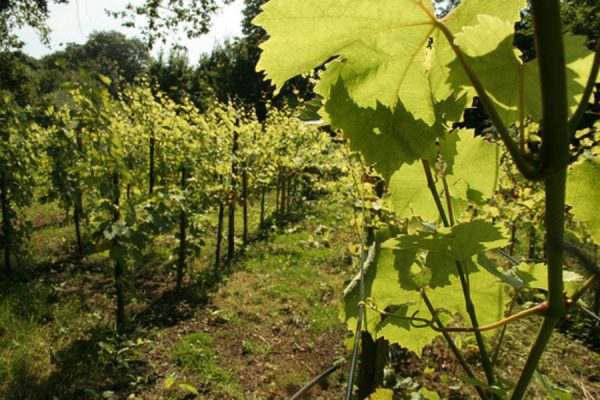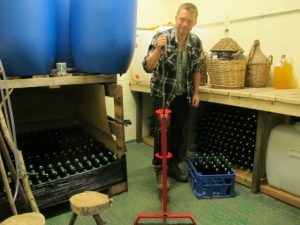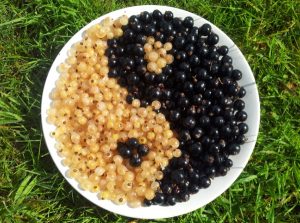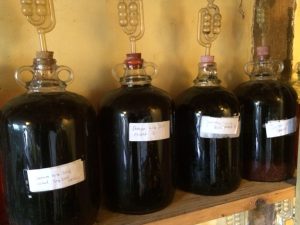It’s that time of year again when the fab folks at OrganicLea invite grape-growing Londoners to join their community wine-making scheme. It’s over to Craig to tell us more, with a useful guide to harvesting grapes to boot.
The community wine-making scheme invites local grape growers to bring their harvest to our Hawkwood Winery to be made into wine for your domestic consumption. We make two batches of wine from all the grapes delivered – a red and a white, and return the finished wine in bottle to the participating growers.
To join the scheme please contact Craig Bayne with the following information: your post code, the expected weight or volume of your harvest, the grape variety, if known, and whether you treat your vines with any sprays.
Dates and how to join
We will be accepting grapes for processing on two dates this year – Saturday 21st September and Sunday 29th September between 12 noon and 3pm. To join the scheme please contact Craig Bayne with the following information: your post code, the expected weight or volume of your harvest, the grape variety, if known, and whether you treat your vines with any sprays.
Are your grapes ripe?
Here’s a quick guide to help you determine if your grapes are ripe.
- Look at the colour of the berries; feel how soft they are; taste individual berries from different bunches to see what proportion of the bunches are already sweet.
- Take a berry between your thumb and first finger and pull it away from the bunch. If it pulls away easily without any resistance your grapes are ripe. If it resists then the grapes can ripen more.
- The skin of a ripe berry will break up when rubbed between the fingers; the broken skin of a ripe black grape will stain the fingers.
- The stem holding the grape bunch to the cane turns brown and shrivels when the grape bunch is ripe.
- If you have a hydrometer or a refractometer then you can accurately measure the sugar content of your grapes. Expect 16-20% sugar by volume in fully ripe London grapes.
Look out for mould and rot
The longer ripe grapes are left on the vine the greater the chance that any rot or mould on them will spread through the bunches. You must judge the right time to harvest the greatest number of the sweetest possible grapes before too many start to spoil.
Although its labour intensive, you can slow down his natural process of decay. Carefully remove mouldy or rotting berries right away from any bunches on which they appear. Use slightly opened scissors or secateurs to pick them out without damaging neighbouring berries. Early removal will prevent disease from slow the spread to the rest of your crop and will ensure you a clean harvest – and therefore a clean wine.
Some of your berries simply shrivel up, but they do not rot: they are simply losing water.
Protect your harvest from predators
As the grapes ripen their sweet smell will attract predators –birds, squirrels, foxes, even humans. Protect the ripening grapes from birds in particular by hanging a net over them or hanging up brightly coloured moving objects like CDs around the vine. Birds are often looking for water when they attack grape vines, so leaving a container of water a little away from your vines might keep them happy. Be vigilant!
Getting ready for harvest and delivery
Plan your harvest so that you can deliver your grapes to the winery within 24 hours of picking them, preferably less. As short a time delay as possible between harvesting and processing the grapes in the winery will minimise the likelihood that your grapes will be infected by unwelcome bacteria, especially the one living on fruit flies that produces vinegar. Fruit flies will appear very quickly over a container of freshly picked grapes.
To pick, store and transport your grapes safely you will need: scissors or secateurs; clean, non-metallic containers for the grapes; cloth and string to firmly cover your containers.
Harvesting
- Pick whole bunches, big or small, and collect them gently in your container. Your container must not have any metal parts. Try to use a rigid sided container like a cardboard box or bucket rather than a bag, so the grapes are not held together tightly or crushed under their own weight.
- Remove and discard any rotting or mouldy grapes before collecting them together.
- Do NOT wash the grapes.
- Keep black and white grapes in separate containers.
- Unless you are delivering the grapes on the day you harvest them, cover them securely with cloth or plastic and string to make sure no flies or animals can get to them.
How to find us
The Hawkwood Winery is located at the Hawkwood Plant Nursery. The address is: 115 Hawkwood Crescent, Chingford, E4 7UH. You can find detailed directions here.
When you arrive
Your grapes will be weighed, crushed, and prepared for fermentation.
The weight of your grapes will determine the number of bottles of wine you can expect to receive from them. Red wine is calculated at 1.5 kilos of grapes for one 750ml bottle. White wine is calculated at 2 kilos of grapes for one 750ml bottle. The reason for the difference is that white grapes are pressed fresh before fermentation and so yield less juice than black grapes which are pressed during fermentation.
Our processing fee is £6.00 per bottle. Half of the fee is payable on delivery of your grapes, the other half on collection of your wine in one year’s time.
We will give you a receipt for your grapes and down payment, and sign a processing agreement with you.
Please get in touch if you have any questions by emailing Craig.
 About the author
About the author
Organiclea is a workers’ cooperative, growing food on London’s edge in the Lea Valley. The co-operative’s main growing site is the Hawkwood Plant Nursery, where its winery and vineyard are also located. From growing and selling food to workshops for schools and community groups, find out more about all that they do here.







